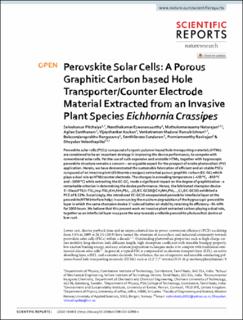| dc.contributor.author | Selvakumar, P | |
| dc.contributor.author | Easwaramoorthy, Nandakumar | |
| dc.contributor.author | Natarajan, Muthukumarasamy | |
| dc.contributor.author | Santhanam, Agilan | |
| dc.contributor.author | Asokan, Vijayashankar | |
| dc.contributor.author | Venkatraman, Madurai Ramakrishnan | |
| dc.contributor.author | Senthilarasu, Sundaram | |
| dc.contributor.author | Ravirajan, Punniyamoorthy | |
| dc.contributor.author | Velauthapillai, Dhayalan | |
| dc.date.accessioned | 2020-08-18T11:19:51Z | |
| dc.date.available | 2020-08-18T11:19:51Z | |
| dc.date.created | 2020-05-21T21:35:36Z | |
| dc.date.issued | 2020 | |
| dc.identifier.citation | Pitchaiya, S., Eswaramoorthy, N., Natarajan, M., Santhanam, A., Asokan, V., Madurai Ramakrishnan, V., Rangasamy, B., Sundaram, S., Ravirajan, P., & Velauthapillai, D. (2020). Perovskite solar cells: A porous graphitic carbon based hole transporter/counter electrode material extracted from an invasive plant species eichhornia crassipes. Scientific Reports, 10(1). | en_US |
| dc.identifier.issn | 2045-2322 | |
| dc.identifier.uri | https://hdl.handle.net/11250/2672794 | |
| dc.description.abstract | Perovskite solar cells (PSCs) composed of organic polymer-based hole-transporting materials (HTMs) are considered to be an important strategy in improving the device performance, to compete with conventional solar cells. Yet the use of such expensive and unstable HTMs, together with hygroscopic perovskite structure remains a concern – an arguable aspect for the prospect of onsite photovoltaic (PV) application. Herein, we have demonstrated the sustainable fabrication of efficient and air-stable PSCs composed of an invasive plant (Eichhornia crassipes) extracted porous graphitic carbon (EC-GC) which plays a dual role as HTM/counter electrode. The changes in annealing temperature (~450 °C, ~850 °C and ~1000 °C) while extracting the EC-GC, made a significant impact on the degree of graphitization - a remarkable criterion in determining the device performance. Hence, the fabricated champion device-1c: Glass/FTO/c-TiO2/mp-TiO2/CH3NH3PbI3−xClx/EC-GC10@CH3NH3PbI3−x Clx/EC-GC10) exhibited a PCE of 8.52%. Surprisingly, the introduced EC-GC10 encapsulated perovskite interfacial layer at the perovskite/HTM interface helps in overcoming the moisture degradation of the hygroscopic perovskite layer in which the same champion device-1c evinced better air stability retaining its efficiency ~94.40% for 1000 hours. We believe that this present work on invasive plant extracted carbon playing a dual role, together as an interfacial layer may pave the way towards a reliable perovskite photovoltaic device at low-cost. | en_US |
| dc.language.iso | eng | en_US |
| dc.publisher | SpringerNature | en_US |
| dc.rights | Navngivelse 4.0 Internasjonal | * |
| dc.rights.uri | http://creativecommons.org/licenses/by/4.0/deed.no | * |
| dc.title | Perovskite Solar Cells: A Porous Graphitic Carbon based Hole Transporter/Counter Electrode Material Extracted from an Invasive Plant Species Eichhornia Crassipes | en_US |
| dc.type | Peer reviewed | en_US |
| dc.type | Journal article | en_US |
| dc.description.version | publishedVersion | en_US |
| dc.rights.holder | © The Author(s) 2020 | en_US |
| dc.source.volume | 10 | en_US |
| dc.source.journal | Scientific Reports | en_US |
| dc.source.issue | 6835 | en_US |
| dc.identifier.doi | https://doi.org/10.1038/s41598-020-62900-4 | |
| dc.identifier.cristin | 1812090 | |
| cristin.ispublished | true | |
| cristin.fulltext | original | |
| cristin.qualitycode | 1 | |

